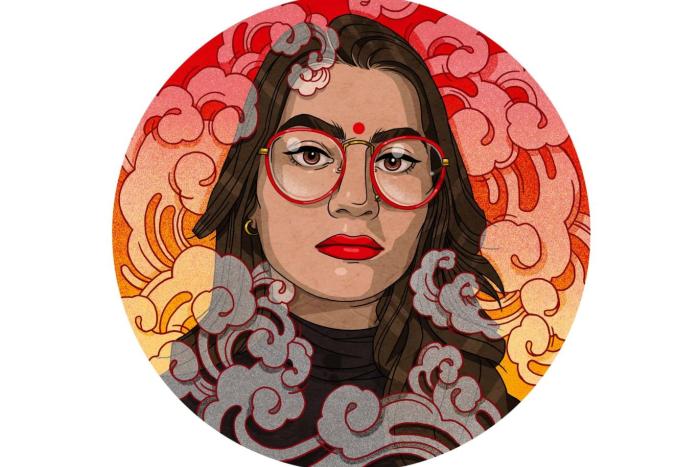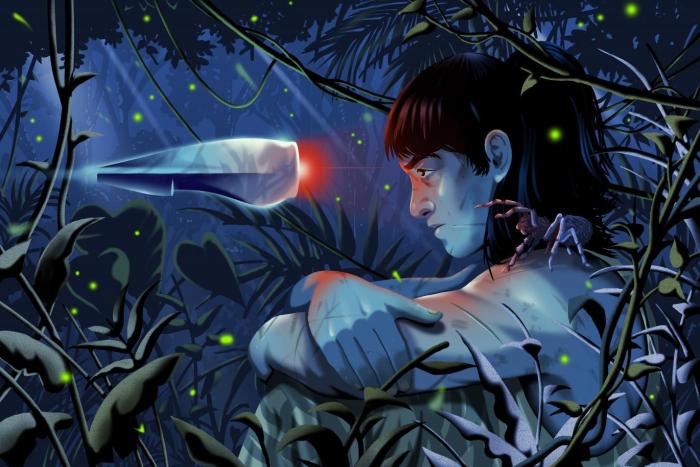Welcome to the third and final instalment of “Brown Hollywood,” a three-part series of essays by Mayukh Sen exploring undertold stories of South Asian performers in Hollywood’s Golden Age.
She has no name; they call her, simply, “Hindu lady.” In the 1956 Hollywood adventure flick The Mountain, all the characters gaze upon this preternaturally beautiful Indian woman as if she’s arrived from another stratosphere. The sole survivor of a plane crash in the Swiss Alps, she wears a cranberry-red bindi between her eyebrows and a diamond stud in her nose. She can speak only Hindi, no English, and whatever she mutters is practically inaudible. She is barely heard, never understood.
You could say the same was true for Anna Kashfi herself. The twenty-two-year-old actress made her Hollywood debut with this pencil sketch of a part, but after what seemed like a promising start, her film acting career was cut short around the end of the decade. By that point, America was more interested in Kashfi’s off-screen role as the vilified first wife of Marlon Brando. At the time of Kashfi’s wedding to Brando in October 1957, headlines were alight with news of the world’s biggest movie star tying the knot with his Indian girlfriend. But soon enough, doubts about “the Grace Kelly of India,” as publicity mavens called Kashfi, emerged: Her parents, in the Welsh city of Cardiff, told the press that their little girl was really named Joan O’Callaghan, and that she wasn’t Indian at all. That she was just white.
That attempt to puncture Kashfi’s credibility had enormous power, and along with her fractious marriage to Brando and ensuing custody battles over their son, it more or less destroyed her blooming acting career. Upon Kashfi’s death in 2015, the matter of her ancestry was still unsettled amongst obituary writers, but most repeated the assertion from the flurry of Brando biographies that she’d outright lied about her heritage. The truth, however, was something only Kashfi herself knew, holding it close for her own protection.
*
Kashfi’s parents were no-shows that day in October 1957 when she wed Brando at his aunt’s house in Eagle Rock, Los Angeles, dressed in a pink lemonade-coloured sari embroidered with gold. On her marriage licence, she marked down her skin colour as “brown.” Barely forty-eight hours passed before journalists started to snoop into her background, delighted to find a factory worker in Wales named William Patrick O’Callaghan. “I can assure you that she is absolutely English and has no Indian blood in her whatsoever,” her father said to a journalist. And so the trouble began.
The scandal that resulted shook the soul of Kashfi’s fragile marriage irreparably. Brando felt betrayed, while Kashfi—a perilously young twenty-three—could barely hold herself together, frequently collapsing into tears. Headlines called her an “illegal bride” because of her use of the seemingly fake name Anna Kashfi on her marriage licence application as opposed to her legal name, Joan O’Callaghan; there was even talk of potential prosecution for fraud. Reporters who seemed to be chomping at the bit to tear her down now had an excuse to damage her name. Though some sympathetic parties were present—the notoriously harsh gossip columnist Hedda Hopper wrote that her “heart aches for this little girl”—most Hollywood insiders sided with Brando and took her parents’ claims at face value, feeling Kashfi had been pulling a long con.
Following her initial despondency, Kashfi refused to take the lashings sitting down. She maintained to the press that her birth parents were Devi Kashfi and Selma Ghose, both Indian. She said that she was born in Calcutta (now Kolkata) and that she had taken her white stepfather William Patrick O’Callaghan’s surname.
Neither party was being completely truthful.
The full, unadulterated facts of Kashfi’s life would not emerge until the publication of Sarah Broughton’s long-overdue biography, Brando’s Bride (2019), a corrective to decades of mistreatment Kashfi had suffered at the hands of the press and Brando’s own biographers. Born in Calcutta as Joan Mary O’Callaghan in 1934, Kashfi was the child of two mixed-race Anglo-Indians—William and Phoebe. After India’s independence from British rule in 1947 and the brutal partition of the land into India and Pakistan (now Bangladesh and Pakistan), her parents decided to decamp for Britain’s greener pastures, no longer feeling that India was a place where they could retain the security of their identity as a minority group.
Eventually settling in the Welsh city of Cardiff, the family found it a necessity, in the predominantly white Gabalfa district where they lived, to lean into the Anglo side of their Anglo-Indian identity, leaving out the Indian one entirely. But Kashfi felt differently. What others in her family wanted to hide she sought to reclaim, also realizing that her coppery skin could be her ticket to a more prosperous future.
Young Kashfi’s beauty tended to stop everyone in their tracks. It was little surprise when she began a career modelling saris for an Indian fashion store in Piccadilly in 1952, around the time she turned eighteen. Three years later, when she heard about a Paramount casting call in Paris for a film called The Mountain, she knew her shot had arrived. That her passport bore the name Joan O’Callaghan didn’t matter to the filmmakers; she looked divine in a sari. After landing the part, a flatmate of hers in London, who worked as a modelling agent’s assistant, suggested that she change her surname to something more suitable for her burgeoning Indian screen image, landing on “Kashfi.” And it was Kashfi herself who reportedly decided to shorten “Joanna,” a variant of her birth name, to Anna. Thus, Anna Kashfi was born.
Within a matter of months, her life changed completely. On her twenty-first birthday in September 1955, she would travel across the Atlantic and end up in Hollywood, where she met Marlon Brando, that man of titanic rage and talent, in the commissary of Paramount. They began dating. By the end of 1955, she had a contract with MGM, and a backstory to go along with it that placed her roots in India. A nasty bout of tuberculosis stalled her career for much of 1956, but she summoned enough strength to complete a pair of films, released over the next two years, where she played women of various ethnic backgrounds: a part-Korean girl in Douglas Sirk’s Korean War drama Battle Hymn (1957), and a Mexican woman in Delmer Daves’s Western Cowboy (1958). In a time when Hollywood allotted so few parts of genuine substance for South Asian actresses, Kashfi’s racial ambiguity was her primary bargaining chip.
When Kashfi first received her MGM contract, the Hollywood commentariat positioned her as the first “East Indian” actress, as they called her, to be signed in the industry (male performers like the Indian-born Sabu had been under contract before). That wasn’t quite true: Kashfi had an antecedent in the Anglo-Indian Merle Oberon, who, upon her arrival in Hollywood during the 1930s, had played along with studio demands to conceal her maternal South Asian ancestry and “pass” for white. It was a time of great prejudice, during which the bluenosing effects of the Hays Code, a creed meant to curb the loose mores of Hollywood films, limited depictions of interracial romance. Meanwhile, restrictive immigration laws outlawed the legal entry and settlement of South Asian immigrants to America. The realities of Oberon’s life, which came to light after her death, have caused some to position Kashfi as Oberon’s inverse, claiming that Kashfi was a white woman role-playing as South Asian for career convenience. But the two women, both Anglo-Indian, were more alike than most realized.
By the time Kashfi arrived in Hollywood, things were different than they had been for Oberon. The immigration laws that had made life so difficult for Oberon and forced her hand had been walked back significantly by 1946’s Luce–Celler Act, which established a quota for the entry of South Asian immigrants into America and allowed South Asian immigrants to obtain American citizenship. (In fact, those quotas were the reasoning Kashfi gave for why her British passport bore the name O’Callaghan: Had she used her Indian passport, she said, she would have been subjected to the years-long slog of awaiting entry into America.) The Hays Code was also undergoing a much-needed gutting; the year of The Mountain’s release, 1956, saw the removal of its antiquated clause on miscegenation, reflecting the changing attitudes of the era.
Some of the more flashy, glamorous aspects of South Asian art had also permeated the American bloodstream by the time Kashfi got her start: Features on Indian fashion items, like saris, were occupying the pages of Vogue and Harper’s Bazaar in the 1950s. The musician Korla Pandit, head beribboned in a turban, also became one of the era’s prominent television stars. While Pandit purported to be Indian, journalists set the record straight after his death, when he was revealed, in fact, to have been a Black man from Missouri named John Roland Redd. Pandit had adopted a false persona that allowed him to cross colour lines in a time of heinous discrimination against African Americans. Pandit’s stardom, too, speaks to the fact that there was social capital to be gained in alignment with South Asian culture.
Even Hollywood was aware of this fact: In 1956, the same year Kashfi made her Hollywood debut, George Cukor’s Bhowani Junction appeared in theatres. The film starred Ava Gardner as an Anglo-Indian woman in India as the nation moves closer toward independence. Much of the film focuses on her struggle to discern where home—literal, metaphorical—is, the community to which she belongs, and whether she should even stay in India or migrate to Britain. These questions aren’t unlike what Kashfi’s own parents likely asked themselves before they made the trek from India to Wales in 1948.
This set of conditions, while less hostile toward South Asians than they had been for someone like Oberon, still didn’t make life easy for Kashfi in Hollywood. The enormous burden she carried rather young, as someone acknowledged to be the first actress of her heritage to gain a Hollywood contract (in a time when Oberon’s background was no more than an open secret at best), may have made the industry especially eager to expose her. Pulling that proverbial rug out from under Kashfi, a more or less untested Hollywood novice who still had much to prove, was far easier than acknowledging that her family history may have been complicated.
Resenting her parents for denying their South Asian ancestry, Kashfi cut off ties with her family, who were confused as to why she absented them from her life on her path to stardom. She never spoke to them again for the remainder of their lives. The disarray of her marriage also gave ample ammo to Kashfi’s critics intent on demolishing her. Brando was a frequently absent husband; she drove herself to the hospital the day she gave birth to their son, Christian Devi, in 1958. The child’s presence did little to settle any rancour between husband and wife. They fought often, with Kashfi admitting that she’d sometimes pull at his hair or throw dishes at him in fury. Kashfi also began to rely on alcohol and barbiturates to pedal her through her days. By March 1959, she filed for a divorce, though the custody battle over their son would last for thirteen years (a battle Kashfi would lose).
The year that Kashfi began divorce proceedings—1959—was the same year that she would make her final of four film appearances. The film Night of the Quarter Moon, a racial drama in which she plays a part-Angolan woman named Maria, suggests the actress Kashfi could’ve blossomed into had she been given a fighting chance by the industry; her cadences have a hypnotically somnolent quality, as if the world has both wearied and hardened her. Kashfi played a supporting role in the movie, that of a woman who is proud of her Black identity and married to a Black man. Most of the film concerns the life of Maria’s light-complexioned cousin—her white husband’s family treats her terribly because of her partial Black heritage. Just after the film’s midpoint, Kashfi’s character warns her mixed-race cousin against consorting with white folk. “A lot of them are nice,” she says of them. “They’re friends with you. They give you jobs. They even go to bed with you. But just don’t try to marry into the family.”
*
Kashfi’s screen career wouldn’t last long, petering out after a smattering of television guest star spots, her last credit being in 1963. The roles conked out in no small part due to the fracas around her racial origins, which effectively made her damaged goods in a town where executives replaced on-screen female talent as easily as they would a disposable straw. America instead cast her as Brando’s unstable, erratic ex-wife.
Kashfi’s public displays of contempt for Brando—say, slapping him after a 1961 court date—earned her a reputation as a firebrand. Arrests after episodes of public belligerence and criminal trials for assault and battery would mark subsequent years, as would an unfortunate incident of negligence in which she kidnapped her son and took him to Mexico, leaving him in the care of strangers. She would recount some of her woes in a searing, elliptical memoir, Brando for Breakfast (1979), its cover bearing the mug of the ex-husband she seemed to despise. In that book, Kashfi would double down on her claims of South Asian ancestry, though still naming her birth parents as Devi Kashfi and Selma Ghose. This was her version of the truth.
She would marry again and, by most accounts, her second husband, James Hannaford, provided Kashfi the peace that otherwise so eluded her. However, his death in 1986 sent Kashfi plunging into instability. Further tragedy struck when, in 1990, her son, Christian, fatally shot the boyfriend of his half sister (they shared a father in Brando). By the time of her son’s 1991 conviction on charges of manslaughter (he would spend nearly five years in prison), Kashfi was living in a trailer home in a city thirty miles outside San Diego. “I’ve come down a lot and learned to live on nothing,” she told the reporter visiting her in 1992.
That America barely got the opportunity to know Anna Kashfi the actress might speak to how little a shot the industry of that era was willing to give a performer like her; how spooked they must have been by a young South Asian woman taking pride in her heritage; how the only way for them to explain her comfort in her own skin was to brand her a liar and forget she existed. That she was married to a demigod of American acting did not help.
“The acting profession tends to attract those with uncertain identities,” Kashfi wrote in her memoir. The line was an attempt to skewer Brando. It may even seem fitting for Kashfi herself at first blush, given the questions about her origins that haunted her in both life and death. But you’d be mistaken if you were to apply the same statement to her. Deep down, Anna Kashfi knew who she was.






